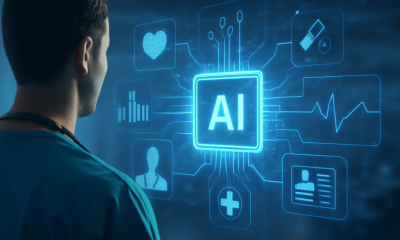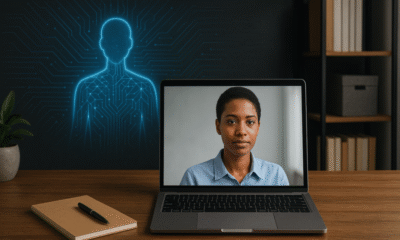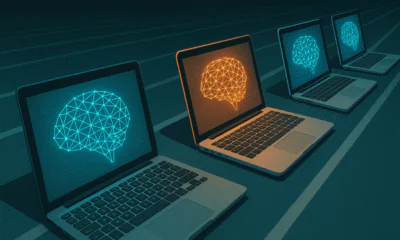Thought Leaders
Unlocking the Future of Healthcare: Exploring AI Ambient Clinical Voice and AI Medical Scribes

The healthcare industry is rapidly entering the next era of its technology-driven story, with AI (artificial intelligence) being a chief accelerator. Data shows that 75% of healthcare providers and professionals think AI-related technologies will be “widespread” in the next three years. While industry leaders are still determining where AI can best serve patients and healthcare professionals, AI medical scribes for clinical documentation are proving to be an impactful use case and cannot be ignored.
Why does this matter to healthcare professionals and patients today?
After the onset of the pandemic and since, healthcare professionals’ workloads have drastically increased. Everything from administrative tasks to patient documentation is causing tremendous daily strain on the lives of healthcare workers and physicians, resulting in significant burnout. Among other leading sources of burnout, about 2 in 5 (41%) say they are simply working too many hours. The industry is looking for effective technological solutions to meet rising patient volume and needs and ensure physician wellness.
Another challenge to overcome is helping healthcare professionals reclaim their time while still providing engaging and thoughtful patient care. A negative patient experience makes a patient three times more likely to change providers. This impacts the practice's bottom line and wears on the mental wellness of workers trying to serve their communities.
Streamlining Patient Care and Enhancing Provider Efficiency
An AI medical scribe is a technology that converts natural conversations between care providers and patients (in-person or telehealth) into clinical documentation. Clinical documentation can contain prescription orders, follow-up appointments, annotations specific to specialty needs, multimodal notes in addition to traditional SOAP notes, summaries of patient findings, etc.
AI medical scribes use AI-powered ambient listening technology to become even more intelligent and intuitive. Ambient listening technology captures conversation in real-time, using natural language processing and advanced AI algorithms to intelligently transcribe and create a dialogue flow. It can capture multiple voices, dialects, and accents, which is crucial for multicultural healthcare.
Ambient clinical voice-enabled AI medical scribes create progress notes for review and assist in completing notes. It also provides appointment summaries and context-aware real-time patient updates, which lead to swift and actionable insights, resulting in better care and patient engagement.
A step-by-step breakdown of an AI medical scribe in action includes:
- A patient steps into a medical office to begin their appointment, and the AI medical scribe is activated.
- Once the conversation begins, the AI medical scribe listens to the conversation for accurate and efficient information capturing.
- Once the appointment concludes, a transcript of the dialog flow is created, capturing all speakers present during the appointment.
- The AI medical scribe will then create a clinical document draft with relevant information from the appointment, allowing the healthcare professional to edit existing information or enter any additional thoughts, next steps, etc.
- An order entry is generated, where the AI medical scribe will insert dialogue and next steps regarding labs, imaging, procedures, medication orders, and follow-up visit details.
- Healthcare professionals receive a final summary of all information, where they can review for accuracy, make modifications if necessary, and merge pre-configured defaults.
An example of an AI medical scribe seeing widespread use across a breadth of practice sizes and disciplines is Sunoh.ai, which integrates into the eClinicalWorks EHR and other leading EHR systems. Sunoh.ai is trusted by over 50,000 providers in the United States. Sunoh.ai is also the first scribe to generate multimodal notes, which is the capturing and interpreting various data types for contextualized clinical documentation.
Bridging the gap: The promise of AI medical scribes
AI medical scribes are one of the first widely adopted AI-powered solutions in healthcare to address challenges for both the patient and the physician. As well as bringing financial benefits to providers and health organizations, AI medical scribes are secure, reliable, and accurate, improving patient trust.
The benefits of adopting an AI medical scribe include:
- Streamlined clinical documentation: Industry data shows that physicians can spend up to 6 hours daily completing electronic health records and clinical documentation. An AI medical scribe can significantly cut down on that time, freeing up more time with patients. A recent industry survey shows that 51% of providers believe an AI medical scribe can save two hours or more each day.
- Addresses physician burnout: There are only so many hours in a day, and streamlining a task as time-consuming as clinical documentation, can be a huge catalyst in allowing physicians to reclaim their day. AI medical scribes lead the charge in enabling physicians to get their work done in a more timely and beneficial manner.
- Makes healthcare interactions more engaging and humane: Because AI medical scribes act as active listeners and documenters in the background, physicians have the opportunity to be more present during appointments. Instead of manually taking notes or entering information, they can focus on the immediate actions of their patient’s needs, or as some providers are coining it, more ‘stethoscope time’. This also helps patients feel heard, which is crucial to maintaining a satisfied and growing patient network.
- Increases accuracy: AI medical scribes reduce the likelihood of manual errors or fatigue, ensuring precise and comprehensive patient records. Physicians also manually review progress notes and transcripts, which adds more certainty to the accuracy of each entry.
- More inclusive healthcare tools: Healthcare equity and inclusive care require continuous improvement in the industry. Ambient clinical voice technology can accurately capture different languages, accents, and dialects in meeting transcripts and progress notes. This allows those seeking care in a country where the native language isn’t their primary language to be heard and better cared for. It also enables practices to take on a more diverse patient network.
The Future of AI Medical Scribes
The introduction and adoption of AI medical scribes will ignite healthcare’s new intelligent era, and with it, a more efficient and accurate healthcare system. With the continued improvements in technology and more providers onboard, there will be even more useful data and use cases to contribute to the ongoing improvement in healthcare documentation. In doing so, the industry will see more satisfied patients and less burnout. As healthcare continues to embrace the innovations of AI medical scribes, opportunities will spread beyond clinical documentation. Each action brings us closer to more inclusive, interactive, and engaging patient care.












